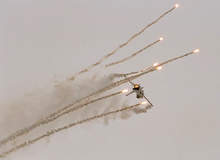
Airborne countermeasures involve the production of off-board decoys to counter the threat of radar-guided and infrared missiles. The history of airborne countermeasures stretches back to the Second World War, when aircraft dropped long strips of aluminium foil, known as ‘windows’, to reflect long-wavelength radar.
They were first used to devastating effect during a massive raid on Hamburg in 1943, blinding radar-guided searchlights and Germany’s night fighters.
Today, the wavelength of the radar has become shorter and radio frequency (RF) countermeasures, which are now called chaff, consist of bundles of aluminium-coated glass fibres, fired from a cartridge that also contains a small amount of propellant. The chaff is cut into lengths, according to the expected wavelength of the threat that is being faced.
Infrared missiles have developed markedly from the sidewinder missiles that were in use in the late 1940s. They are increasingly sophisticated and incorporate radar. Furthermore, the development of the shoulder-launched guided missile, in particular, has boosted the potency of the threat facing today’s aircraft as fire-and-forget missiles, such as the Stinger, proliferate around the world.
Decoys have been developed to counter infrared-seeking missiles. These decoys lure the missile away from the target by appearing as a more attractive heat source than the aircraft itself.
Helicopters and the growing countermeasure market
How well do you really know your competitors?
Access the most comprehensive Company Profiles on the market, powered by GlobalData. Save hours of research. Gain competitive edge.

Thank you!
Your download email will arrive shortly
Not ready to buy yet? Download a free sample
We are confident about the unique quality of our Company Profiles. However, we want you to make the most beneficial decision for your business, so we offer a free sample that you can download by submitting the below form
By GlobalDataOne of the most important trends in recent years has been the increasing deployment of countermeasures on helicopters. During the Cold War, helicopters were regarded as disposable, while combat aircraft were protected with flares. But in combat zones such as Afghanistan and Iraq, helicopters have emerged as mission-critical workhorses. Furthermore, they are the only safe form of transport given the ubiquitous threat from roadside bombs. This has not stopped helicopters becoming the terrorists’ ‘target of choice’, according to UK countermeasures specialist Chemring’s business development director Rick Armitage.
“It is far easier to shoot down a helicopter [a slow-moving and low-flying target] than a combat aircraft – you can kill more of the hated enemy,” Armitage says.
Consequently, flare dispensers are now fitted to helicopters. Indeed almost all of the UK’s helicopters, whether they are transport or attack models, are equipped with flare dispenser or missile approach warning systems. Similarly, the US armed forces (in particular the US army) have adopted defensive technology on their helicopters.
Overall, the adoption of flares for helicopters has been an important driver in the growth of the overall aircraft countermeasures market which is currently worth about £300m a year. Armitage adds that Chemring accounts for around half that market.
Retaliating with arms
Missile makers have not been slow to react to the increasing deployment of countermeasures on helicopters and have been seeking to develop countermeasure rejection techniques. Flares have very different characteristics to aircraft – a flare will tend to fall behind an aircraft while its spectral characteristics are also quite different from an aircraft’s exhaust pipe. As a result, missile makers are seeking to develop technology that enables missiles to focus on the spectral characteristics of the aircraft itself.
Countermeasures suppliers have responded by developing spectral flares, which more closely mimic the aircraft’s characteristics. These flares are already in production and undergoing further development.
Flares also travel at a different speed to aircraft. A flare that is thrown out of the back of an aircraft will clearly fall behind the aircraft and move more slowly. It has been relatively easy for missile makers to develop technology that enables the missile to compare the two targets and reject the flare. Consequently, flares have been developed to be either fired from a forward-facing sensor or to incorporate some degree of rocket thrust.
“You now have a flare that moves ahead of the aircraft and behaves more like an aircraft than the aircraft itself.” Armitage says. These flares are already in production and are undergoing further development.
Other types of heat seekers in the developed world marketplace are even more advanced than the countermeasures Chemring is currently working on. But the insurgent threat facing the armed forces in Afghanistan and Iraq is based on technology that is ten or 20 years old. An Iranian clone of older Russian missile technology has made its way into Afghanistan, for example.
Countermeasures specialists such as Chemring have good foresight into what the next generation of missiles will look like. “While traditional seekers were relatively dumb and looked for a simple heat source, we know that seekers are being developed which look at imaging,” Armitage says.
The development of computer processors capable of implementing complex image-processing algorithms in real time is driving the threat from missiles which focus on imaging. These missiles are much more accurate than traditional heat seekers and are harder to fool with decoys. Fortunately, Armitage says, “we have the technology to counter this threat.”
In other words, companies such as Chemring currently appear to have the edge over the missile makers in countries such as China and Russia and rogue states such as North Korea and Iran, which produce missile clones.



